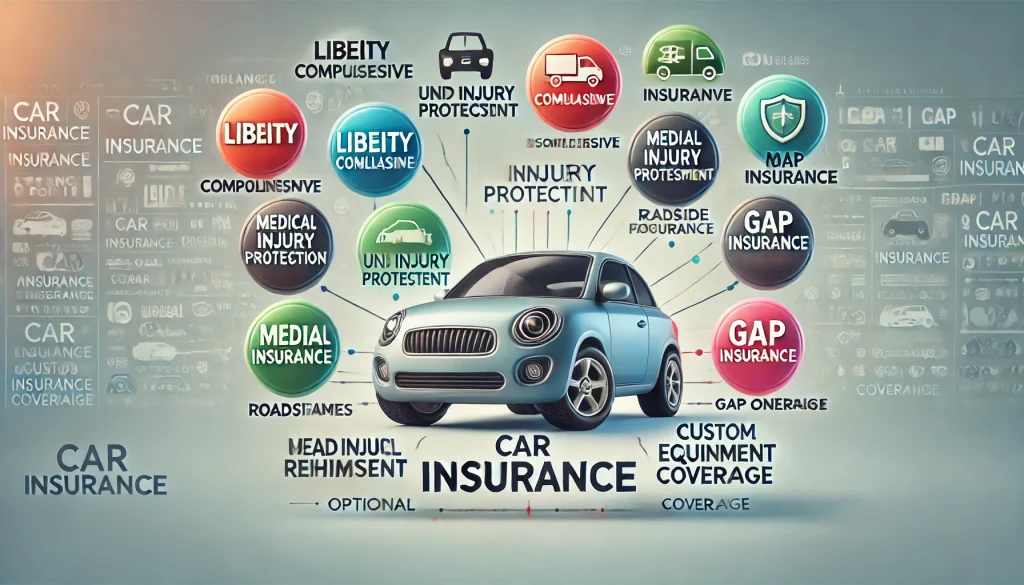What are the Different Types of Car Insurance Coverage?
Confused about car insurance? Our guide explains the different types of car insurance coverage, including liability, collision, and comprehensive.

Car insurance is essential for protecting yourself and others on the road. With various types of coverage available, it can be overwhelming to choose the right one for your needs. This guide will help you understand the different types of car insurance coverage and their benefits, so you can make an informed decision.
Liability Coverage
Liability coverage is the foundation of most auto insurance policies. It covers damages you cause to other people and their property. There are two main types of liability coverage:
- Bodily Injury Liability: This covers medical expenses, lost wages, and pain and suffering for the other party if you’re at fault in an accident.
- Property Damage Liability: This pays for damage you cause to another person’s property, such as their car, house, or fence.
Liability coverage is crucial because it helps protect you from financial loss if you are found legally responsible for an accident.
Collision Coverage
Collision coverage pays for damage to your car resulting from a collision with another vehicle or object, regardless of who is at fault. This coverage is particularly useful if you have a newer vehicle or if you’re financing your car, as it helps cover repair or replacement costs.
For example, if you hit a tree or another car, collision coverage would pay for the repairs to your vehicle, minus your deductible.
Comprehensive Coverage
Comprehensive coverage protects your car from non-collision-related incidents. This includes events like theft, vandalism, natural disasters, fire, and hitting an animal. Comprehensive coverage is ideal for those who want extensive protection for their vehicle.
Benefits of comprehensive coverage include peace of mind and financial protection against a wide range of potential damages.
Personal Injury Protection (PIP)
Personal Injury Protection (PIP) is also known as “no-fault” insurance. It covers medical expenses, lost wages, and other costs for you and your passengers, regardless of who is at fault in an accident. PIP is mandatory in some states and optional in others.
PIP is especially important in no-fault states, where each driver’s insurance pays for their own injuries, regardless of who caused the accident.
Uninsured/Underinsured Motorist Coverage
Uninsured/underinsured motorist coverage protects you if you’re involved in an accident with a driver who doesn’t have enough insurance or any insurance at all. This coverage can pay for your medical bills and car repairs.
This type of coverage is essential because, despite legal requirements, many drivers on the road are uninsured or underinsured, leaving you vulnerable if they’re at fault in an accident.
Medical Payments Coverage (MedPay)
Medical Payments Coverage, or MedPay, covers medical expenses for you and your passengers after an accident, regardless of who is at fault. It typically covers hospital visits, surgery, X-rays, and more.
MedPay is similar to PIP but usually provides less extensive coverage. It’s a good option if you want additional medical coverage but don’t live in a state that requires PIP.
Gap Insurance
Gap insurance covers the difference between what you owe on your car loan or lease and the car’s actual cash value if it’s totaled or stolen. This is particularly important for those with new or financed cars, as the car’s value depreciates quickly, often leaving a “gap” between the loan amount and the car’s worth.
For example, if your car is totaled and you owe $20,000 on your loan, but the car’s value is only $15,000, gap insurance would cover the $5,000 difference.
Optional Coverages
There are several optional coverages you can add to your policy for additional protection:
- Roadside Assistance: This includes services like towing, battery jump-starts, and flat tire changes. It’s useful for drivers who want peace of mind on the road.
- Rental Reimbursement: This covers the cost of a rental car while your vehicle is being repaired after a covered accident. It ensures you won’t be left without transportation.
- Custom Equipment Coverage: This covers aftermarket or custom parts added to your car, such as a new sound system or custom wheels. It’s essential for those who have invested in personalizing their vehicle.
Conclusion
Understanding the different types of car insurance coverage is crucial for selecting the right policy for your needs. From liability and collision coverage to comprehensive and gap insurance, each type offers unique benefits and protections. Assess your individual needs, consider your state’s requirements, and choose the coverage that provides the best protection for you and your vehicle.




